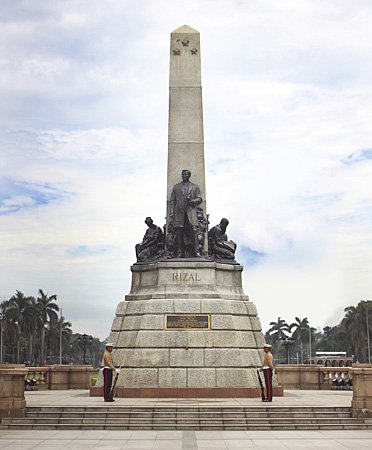Cultural Center of the Philippines
ENCYCLOPEDIA OF
PHILIPPINE ART
Rizal National Monument
1913 / 12.7 m / Bronze figures on granite base / Artist: Richard Kissling / Rizal Park, Manila
The Rizal Monument is a national monument and the tomb of Philippine hero Jose Rizal. Designed by Swiss sculptor Richard Kissling (1848-1919) and unveiled in 1913, it is a sculptural group consisting of a cast bronze statue of Rizal with allegorical figures and a granite obelisk on a base where his remains are interred. It is located in Rizal Park or Luneta (formerly Bagumbayan), Ermita, Manila, near the site of Rizal’s execution and is adjacent to the Independence Flagpole and across the Kilometer Zero marker.
In 28 Sep 1901, the United States (US) Philippine Commission passed Act No. 243 “granting the right to use public land upon the Luneta … upon which to erect a statue to Jose Rizal.” The act also created a committee to raise funds for its erection by public subscriptions. Two other legislative acts facilitated its construction. Act No. 893, enacted by the Philippine Commission on 19 Sep 1903, appropriated 15,000 US dollars as contribution of the Insular Government. On 9 Jan 1906, the Philippine Commission further approved Act No. 1436 granting free entry of the materials for the monument. An international competition for the design of the monument was announced on 15 Mar 1905. Winning entries among the 40 scale models were disclosed on 16 Dec 1907 with Italian Carlos Nicoli’s Al Martir de Bagumbayan (To the Martyr of Bagumbayan) and Kissling’s Motto Stella (Guiding Star) garnering the first and second prizes. The contract was eventually awarded to Kissling on 11 Oct 1910 reportedly due to Nicoli’s “failure … to sign the contract according to his agreement.” In 1912, Rizal’s remains, which were contained in an urn, were reinterred in the monument. They were transferred from his sister Narcisa’s house in Binondo to the Ayuntamiento in Intramuros and finally to the base of the monument. The monument was inaugurated the following year during Rizal’s 15th death anniversary.
The classical depiction of Rizal in an overcoat appears to have been partially based on his studio portrait with Marcelo del Pilar and Mariano Ponce taken in Madrid. The inclusion of a book alludes to his novels and other writings. Other figures on the base encircling the three sides of the monument include a woman cradling an infant and a man with a boy reading a book. All figures emphasize the importance of education. Renato Constantino (1970) cites the monument as an example of the American sponsorship of Rizal as national hero. Others have pointed out though that Rizal was already revered as a hero even before US intervention. The monument’s design elements have been appropriated in numerous Rizal monuments in and outside the Philippines, including those in Madrid and Jinjiang City, China.
On September 1961, as part of the National Cultural Shrine project of the Jose Rizal National Centennial Commission, the Rizal monument was remodeled by superimposing a stainless steel shaft over the granite obelisk, increasing the height of the monument from 12.7 m to 30.5 m. However, the modernist design of Juan F. Nakpil and Sons was criticized by some government officials and members of the press—notably, Secretary of Education Alejandro R. Roces and National Library director Carlos Quirino. The shaft was eventually removed in April 1963.
Since the 1960s, honor guards from the Philippine Marine Corps have been posted at the monument. It has likewise become customary for visiting heads of state to lay wreaths at the monument. During its centenary in 2013, the Rizal monument was declared a national cultural treasure and a national monument by the National Museum of the Philippines and by the National Historical Commission of the Philippines, respectively.
Written by Roberto Eliseo G. Paulino (2018)
Source
Constantino, Renato. 1969. “Veneration without Understanding.” Lecture, Third Annual Rizal Lecture, Fort Santiago, Manila, 30 Dec 1969. In The Third Annual Annual Jose P. Rizal Lectures (Manila: National Historical Commission, 1970), 1-23; Dissent and Counter-Consciousness (Quezon City: Malaya Books Inc, 1970), 125-45; Selected Rizal Day Lectures, (Manila: National Historical Institute, 2002), 39-60.
